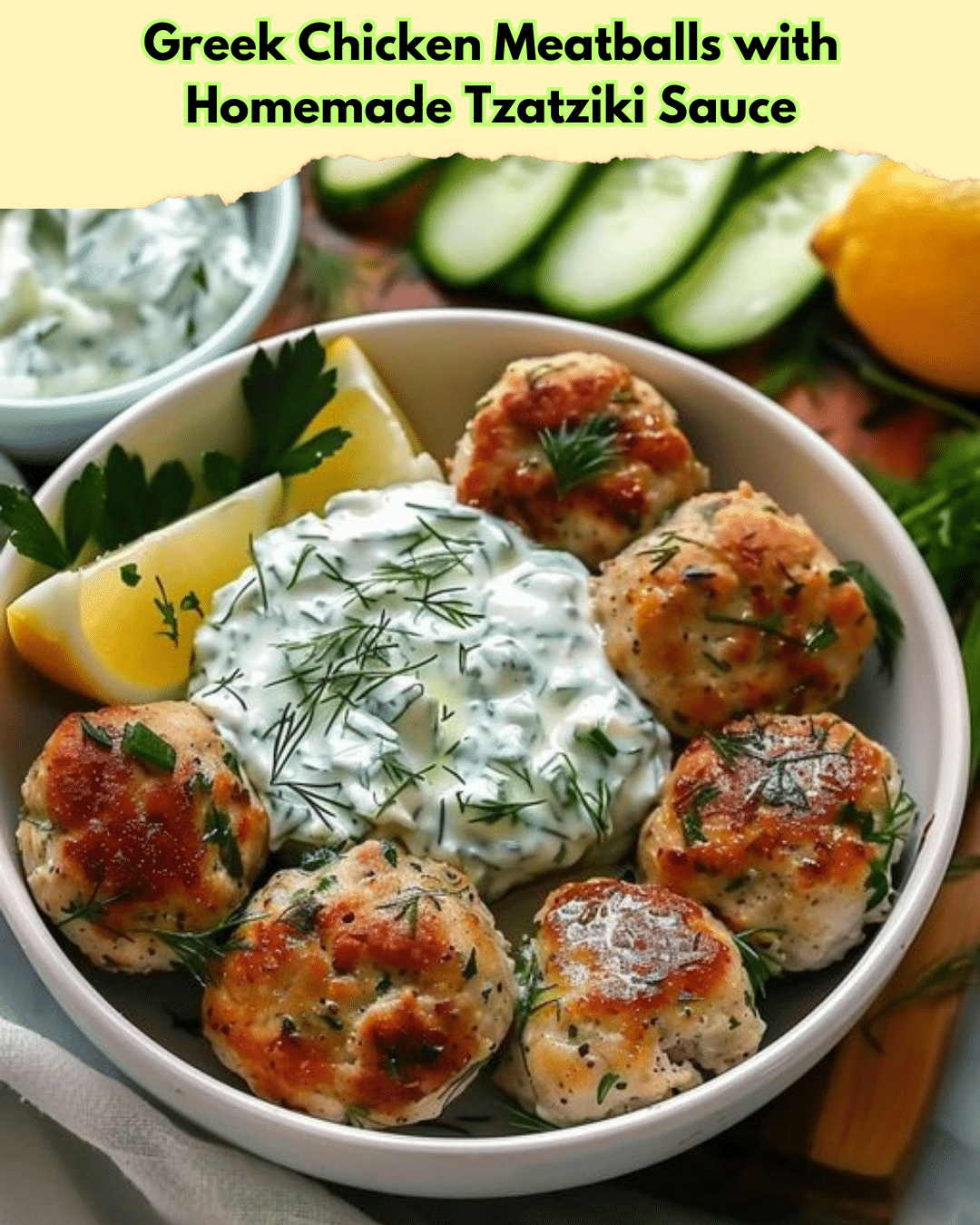Greek Chicken Meatballs with Homemade Tzatziki Sauce: A Mediterranean Delight
Imagine savoring Greek Chicken Meatballs with a Homemade Tzatziki Sauce that takes you straight to the Mediterranean. This delightful recipe brings together the rich flavors of garlic, dill, and perfectly seasoned chicken in a confection that’s both tender and robust. The creamy, tangy tzatziki complements the meatballs beautifully, offering a refreshing contrast that’s perfect for any meal. Whether you’re preparing a casual weeknight dinner or a weekend feast, these Greek chicken meatballs will surely become a staple in your recipe collection.
The beauty of these Greek chicken meatballs lies in their simplicity and elegance. The recipe boasts a lovely balance of spices that highlight the chicken’s natural flavors, creating a dish that’s healthier and equally satisfying. Pair it with the homemade tzatziki for a cooling effect that brings out a vibrant burst of freshness with each bite. This memorable dish is sure to leave your taste buds longing for more.
The Greek Chicken Meatballs with Homemade Tzatziki Sauce is a journey into traditional Mediterranean cuisine that can be adapted to suit various preferences. The method is straightforward, with a focus on authentic flavor integration that provides a true taste of Greece. You’ll find this dish perfect for any occasion, be it a day at home or a festive gathering with friends and family.
Quick Recipe Highlights
- Flavor Profile: A harmonious blend of garlic, dill, and lemon infused into juicy chicken meatballs, balanced by a creamy, tangy tzatziki sauce.
- Texture: The meatballs offer a tender, succulent bite, enhanced by the smooth, cool creaminess of the tzatziki, creating a pleasant mouthfeel.
- Aroma: Rich garlic and fresh dill aromas dominate, carrying the savory scent of perfectly cooked chicken with a hint of lemon zest.
- Visual Appeal: Golden-brown meatballs with a vibrant, creamy white sauce dotted with green cucumber and herbs, set against a fresh salad backdrop.
- Skill Level Needed: Easy to moderate; suitable for cooks comfortable with basic chopping and shaping meatballs, grilling or pan-searing.
- Special Equipment: A grater for the cucumber and a non-stick skillet or oven for cooking the meatballs.
Recipe Overview
- Difficulty Level: This recipe is marked as easy due to its straightforward steps and minimal prep work. Even novice home cooks can achieve delicious results.
- Category: Ideal for dinner or lunch, this recipe falls into the main course category, suitable for everyday meals or special occasions.
- Cuisine: Rooted in Mediterranean and Greek culinary traditions, known for fresh flavors and healthful ingredients.
- Cost: Budget-friendly as chicken is an economical choice, with readily available spices and herbs, and homemade tzatziki being cost-efficient.
- Season: Best enjoyed year-round, as its fresh components and light nature complement all seasons, particularly summer.
- Occasion: Perfect for family dinners, gatherings, or meal prep, offering a versatile dish that can be dressed up or down.
Why You’ll Love This Recipe
Imagine a dish that satisfies your cravings for Mediterranean cuisine while being simple enough to prepare on a busy weeknight. Greek Chicken Meatballs deliver just that. The taste is a delightful blend of carefully selected spices and herbs, wrapped in succulent chicken that’s both flavorful and filling. The homemade tzatziki complements each bite with its freshness, making the dish well-rounded and complete.
One of the main conveniences of this recipe is the ease of preparation. With less than an hour needed from start to finish, you’ll have a meal that can quickly become part of your regular rotation. Ingredients are accessible, and the cooking process is straightforward, requiring no special techniques or lengthy marination times. Even reheating the leftovers makes for a speedy lunch the following day.
On the nutritional spectrum, Greek Chicken Meatballs with Tzatziki are a standout. Using lean meat reduces fat intake, while herbs and spices provide antioxidant benefits. Moreover, the refreshing tzatziki sauce is relatively low in calories and offers the probiotics of yogurt and the hydrating qualities of cucumber.
Serving these meatballs at gatherings will undoubtedly wow your guests. Their presentation is stunning, creating a delightful centerpiece for entertaining. The flavors and textures invite a communal experience enjoyed around the dinner table, encouraging connection and conversation.
This recipe provides incredible value. Skills involved are minimal, and the ingredient list is accessible to all budgets. Whether you’re feeding a small family or multiplying the ingredients to cater to a crowd, this dish remains economical while delivering maximum taste and satisfaction.
Historical Background and Cultural Significance
Greek Chicken Meatballs are inspired by the Greek dish keftedes, traditionally made with beef or lamb. This chicken version is a leaner, versatile adaptation. In Greek culture, meals are centered around family, featuring shared dishes like these meatballs, fostering togetherness.
Greece is home to a history-rich cooking style, heavily influenced by neighboring countries and thriving on abundant local ingredients. Meatballs, or keftedes, have evolved from ancient recipes, adapting to the diverse landscapes and resources across regions. The addition of tzatziki is emblematic of modern Greek cuisine, pairing meats with refreshing sides.
Tzatziki, with its roots in the Ottoman Empire, finds its place alongside various dishes in Greek cuisine. Initially a street food accompaniment, it evolved into a beloved household condiment. Each Greek region contributes its twist on tzatziki, making it a versatile component of their culinary identity.
Despite changes over time, the combination of meatballs and tzatziki has remained popular, symbolizing the fusion of historical influences and contemporary adaptations. As global tastes seek healthy yet delicious meal options, such dishes gain international recognition, showcasing Greek culinary flexibility.
Ingredient Deep Dive
Chicken, the star ingredient in these meatballs, has significant cultural and nutritional importance. Lean and protein-rich, it’s a healthy choice for many cuisines, providing essential amino acids and B vitamins. When selecting chicken, opt for organic or free-range options to enhance flavor and nutritional benefits.
Dill is integral to Greek cuisine and tzatziki. Its distinct flavor brings a bright, fresh note to dishes. Rich in antioxidants, dill supports digestive health and inflammation reduction. Keep dill fresh by storing it in a damp paper towel inside an airtight container in the fridge. Substitute with dried dill in small amounts if necessary.
Lemon juice in this recipe adds brightness and a citrusy zing that balances the dish’s rich flavors. A good source of vitamin C, lemons also have natural preservative properties. Choose lemons with thin skin and feel heavy for their size for juicing. Keep lemons room temperature to ease juicing. As a substitute, bottled lemon juice can be used sparingly.
Cucumber, a key component in tzatziki, provides hydration and a subtle cooling effect essential in balancing flavors. Rich in vitamin K, cucumbers support bone health. When selecting, choose firm cucumbers without soft spots. Store them in the fridge for optimal freshness, and substitute with zucchini if desired for a different flavor.
Greek yogurt, creamy and tangy, is crucial for tzatziki sauce. Loaded with probiotics, it aids digestion and enriches the sauce’s creamy texture. While selecting, opt for full-fat varieties for a richer flavor. If unavailable, mix regular yogurt with a bit of sour cream.
Common Mistakes to Avoid
- Overworking the meat mixture can lead to dense meatballs. Gently mix just until combined to maintain moisture.
- Under-seasoning the mixture can result in bland taste. Ensure all elements are well-seasoned to balance flavors.
- Neglecting to grate cucumber for tzatziki makes the texture too watery. Squeeze excess moisture from grated cucumber before mixing.
- Using low-quality herbs diminishes flavor complexity. Choose fresh herbs for the most vibrant taste.
- Overcooking meatballs leads to dryness. Cook until just done, keeping them tender and juicy.
- Skipping resting time prevents flavors from melding. Allow meatballs to rest briefly before serving.
- Serving tzatziki too warm dulls its refreshing quality. Chill the sauce for optimal contrast with warm meatballs.
- Insufficient pan or grill preparation causes sticking. Ensure the cooking surface is preheated and lightly oiled.
- Incorrect mixing order affects meatball texture. Integrate dry ingredients with wet components for consistent results.
- Ignoring portion control leads to uneven cooking. Shape meatballs uniformly for even cooking and presentation.
Essential Techniques
Mixing: Proper ingredient blending techniques are crucial for texture. Stir gently with a fork to avoid compacting meat, ensuring tender results. Avoid overmixing, which toughens the meat and disrupts the meal’s balance.
Resting: Allow the chicken mixture to rest briefly, absorbing flavors and tenderizing the meat. Resting also helps achieve uniform cooking when shaped into meatballs. Overlapping tasks during resting optimizes kitchen efficiency.
Squeezing cucumber: Removing excess moisture prevents watery tzatziki. Use your hands or cheesecloth to squeeze grated cucumber, maintaining tzatziki’s thick, creamy consistency. Avoid over-squeezing, which can dry out the cucumber entirely.
Browning: Achieving a golden crust on meatballs enhances flavor. Use medium heat to brown them evenly, locking juices inside. Monitor closely to prevent burning, which affects taste and appearance.
Chilling: Proper chilling of tzatziki enhances its refreshing quality. Allow flavors to meld and thicken for authenticity. Serve cold to contrast with warm, juicy meatballs, offering the quintessential Greek experience.
Pro Tips for Perfect Greek Chicken Meatballs
Maintain meat moisture by incorporating egg and bread crumbs in the mixture, ensuring tender, flavorful meatballs. Avoid overhandling, preventing toughness.
Use a gentle seasoning approach, balancing herbs and spices to complement rather than overpower chicken’s natural flavors. Taste-test small portions before cooking all meatballs.
Ensure uniform meatball sizes for even cooking, preventing some from drying out while others remain undercooked. Utilize a small ice cream scoop for consistent portioning.
Select high-quality Greek yogurt, enhancing tzatziki’s creamy texture and taste. Full-fat varieties provide a richer experience, balancing meatballs’ robust qualities.
After grating cucumber, allow extra time for draining; consider salting lightly as well for moisture extraction, preserving tzatziki’s thick, creamy texture.
Craft a crispy exterior by browning in the pan before transferring to the oven, if necessary, ensuring evenly cooked and deliciously crispy meatballs.
Incorporate finely minced fresh garlic for authentic depth of flavor, enhancing both meatballs and tzatziki, perfecting their harmonic interaction.
Use kitchen shears to efficiently cut dill and other herbs for the tzatziki, achieving a fine, consistent texture that melds seamlessly with yogurt.
Variations and Adaptations
Explore regional variations by incorporating locally inspired spices such as cumin or coriander, creating new flavor profiles while honoring this Greek classic.
Adapt seasonally by experimenting with fresh, local herbs; try mint or parsley for summer, or stick to dill and oregano in cooler months.
Ensure inclusivity with dietary modifications: Opt for gluten-free bread crumbs or ground flaxseed if needed, maintaining texture and flavor.
Create flavor variations by adding roasted garlic or sun-dried tomatoes into the meatball mix, imparting savory depth and complexity.
Achieve satisfying texture modifications by using coarsely ground chicken for a heartier bite, contrasting with smooth tzatziki creaminess.
Consider elegant presentation alternatives by shaping smaller meatballs for party appetizers, allowing easy portioning and impressive serving displays.
Serving and Presentation Guide
For visually appealing plating, present meatballs atop a bed of fresh, leafy greens like arugula, providing an attractive contrast to their golden-brown finish.
Add garnishing ideas, such as freshly chopped parsley or dill, lightly scattering across the dish for complementary color and herbs.
Encourage traditional accompaniments by serving with warm pita bread or fresh Greek salad, immersing diners fully in a Greek culinary experience.
Modernize serving suggestions by pairing meatballs with a quinoa salad, infusing meals with contemporary touches and additional nutrition.
Maintain optimal temperature considerations by ensuring tzatziki is chilled just before serving, maintaining its refreshing effect on warm meatballs.
Adopt portion control tips for meal planning; plate 3-4 meatballs per person with sauce and vegetables or pita, creating balanced, satisfying meals.
Wine and Beverage Pairing
Select wine pairings like a crisp Greek Assyrtiko or a chilled Sauvignon Blanc, enhancing the fresh herb and citrus notes in the meal.
Choose non-alcoholic alternatives such as iced herbal tea, like lemon verbena or mint, refreshing the palate and accentuating tzatziki’s cool flavors.
Consider coffee/tea pairings with herbal blends post-meal, like chamomile or peppermint, offering relaxing endings that echo meal flavors.
Ensure appropriate temperature considerations by chilling white wines briefly before serving, complementing the meal’s fresh overall theme.
Enhance serving suggestions by providing guests with tailored offerings: sweet rosé for fruity profiles or spring waters for subtle cleansing effects.
Storage and Shelf Life
Proper storage methods ensure taste and texture preservation; place meatballs and tzatziki in airtight containers, keeping them fresh for up to three days.
Store meatballs in fridge-safe containers at a recommended temperature of 40°F, maintaining their original flavor profiles.
Invest in container recommendations like glass or BPA-free plastics, preserving essential oils and aromas without chemical interference.
Watch for signs of spoilage such as discoloration or sour odors in meatballs and tzatziki, indicating possible food safety issues.
Reheating instructions advise gently warming meatballs in a preheated oven, avoiding microwaving to maintain their texture.
Explore freezing guidelines with cooked meatballs, storing them in tightly-sealed bags; thaw overnight in the fridge before reheating for best results.
Make Ahead Strategies
Organize prep timelines effectively by crafting meatball mixture days in advance; allow flavors to marry overnight or freeze for future use.
Utilize storage between steps, prepping tzatziki the night before to ensure well-infused flavors when serving the following day.
Assess quality impact on make-ahead strategies, ensuring retained freshness and flavor integrity, delivering equally delightful results.
Refine assembly tips with batch cooking meatballs, storing them in groups for scheduled meals, simplifying dinnertime routines.
Consider reheating guidelines, warming pre-cooked meatballs in low-heat ovens, maintaining crispy exteriors and juicy interiors.
Incorporate fresh element additions like freshly squeezed lemon juice on reheated meatballs, reviving flavors instantly when serving.
Scaling Instructions
Effectively halve the recipe for smaller gatherings, adjusting ingredients proportionately to maintain flavor core, ensuring even seasoning.
Double or triple the recipe for larger settings, taking into account slight seasoning adjustments to accommodate increased volume.
Adopt equipment adjustments; use larger pans or baking sheets to accommodate more meatballs without overcrowding during cooking.
Update timing modifications due to larger or smaller batches; monitor cooking closely to adjust as necessary, achieving consistent results.
Implement storage considerations with scaled recipes, portioning extras for effective storage or creating meal plans for upcoming days.
Nutritional Deep Dive
Delve into macro breakdowns; these chicken meatballs provide lean protein with balanced carbohydrates, supporting dietary requirements.
Engage with micronutrient analysis, noting vitamin and mineral contributions from fresh herbs and recent produce like cucumber and lemons.
Promote health benefits recognized in Greek cuisine, emphasizing digestion-friendly tzatziki and lean, protein-rich meatball compositions.
Ensure dietary considerations where possible; cater gluten-free intentions with substitute ingredients while maintaining authentic tastes.
Provide portion analysis guidance; aim for averaging 330 calories per serving, a balance of protein, healthy fats, and nourishing vegetables.
Include weight management tips, recommending this satisfying meal for portion control approaches common in balanced diet plans.
Dietary Adaptations
Explore gluten-free options, relying on gluten-free bread crumbs, ensuring flavor and texture without compromising specific dietary needs.
Create dairy-free alternatives by selecting non-dairy Greek yogurt varieties, achieving creamy tzatziki yields without sacrificing authenticity.
Introduce vegan substitutions using plant-based meat alternatives and vegan yogurt, expanding accessibility to diverse dietary preferences.
Advocate for low-carb adjustments, substituting with almond flour to bind or mixing with cauliflower rice as a trusted alternative.
Provide keto-compliant versions by reducing cucumber content, aiming to enhance tzatziki richness, aligning with keto goals.
Offer paleo-style adaptations, using almond flour in meatballs and compliant yogurt, supporting paleo tastes maintaining Greek origins.
Customize low-FODMAP adaptations by excluding garlic, opting for garlic-infused oil, maintaining distinct flavors without digestive distress.
Address other specific diets by advising substitutes like reducing sodium content, amplifying heart-healthy solutions, widening appeal.
Troubleshooting Guide
Solve texture issues by adjusting bread crumb ratios or employing binders; ensure a moist yet firm meatball mixture, addressing common dryness.
Balance flavor profiles by addressing over-seasoning; dilute spices subtly while increasing moisture elements if necessary, restoring harmony.
Tackle temperature problems by monitoring cooking; ensure even heat distribution in a lightly oiled skillet or preheated oven for perfecting results.
Overcome equipment challenges with nuanced steps; adapt cooking methods such as pan-searing or bake-broiling for consistency.
Navigate ingredient substitutions intelligently; assess individual tolerance for various herbs or breadcrumb alternatives if original unavailable.
Manage timing concerns considering recipe preparation; prioritize steps ensuring simultaneous coordination, streamlining processes efficiently.
Recipe Success Stories
Capture community feedback from readers who’ve integrated this recipe into their kitchens, expressing appreciation for its flavors and ease.
Chronicle variation successes, recounting stories from diverse home chefs innovating with spices and region-specific adaptations.
Share adaptation stories highlighting individual endeavors modifying traditional elements, offering personalized takes on this classic.
Include reader suggestions illuminating novel approaches to presentation or pairing, nurturing inspiration for prospective attempts.
Offer photography tips from enthusiasts detailing successful imagery captures, elevating final dish presentations shared online.
Frequently Asked Questions
To keep chicken meatballs moist, avoid overworking the mixture and incorporate ingredients like eggs and breadcrumbs that lock in moisture.
What do I do if my tzatziki is too watery?
If tzatziki is too watery, ensure cucumber is thoroughly squeezed before mixing, or let the sauce sit in the fridge to thicken.
Can I grill the meatballs instead of baking?
Yes, grilling is a great option to infuse a smoky flavor while maintaining juiciness. Ensure they are consistently sized for even grilling.
Is it necessary to use Greek yogurt?
Greek yogurt is recommended due to its thickness and tartness, yet alternatives like regular yogurt or dairy-free substitutes work.
What can I substitute for dill in the tzatziki?
If dill is unavailable, mint offers a refreshing alternative, infusing the sauce with complementary herbal flavors.
How long does tzatziki last in the fridge?
Tzatziki can be stored in the fridge within an airtight container for up to three days, maintaining freshness and flavor.
Can I use beef instead of chicken?
Yes, beef provides a heartier flavor and different texture to meatballs, but cooking times may vary slightly with the change.
What can I serve with Greek chicken meatballs?
Pairing with fresh salads, roasted vegetables, or warm pita offers complete Greek dining experiences, complementing the meal well.
Is it okay to freeze the meatballs?
Freezing is perfectly fine; pre-cooked meatballs must be stored in air-tight containers or bags, reheated with care post-defrost.
Can Greek chicken meatballs be made ahead of time?
Yes, making them ahead and reheating ensures even greater flavors, allowing pre-planned dining experiences without hassle.
Additional Resources
Consider related recipes within Greek cuisine, such as moussaka or souvlaki, extending culinary excursions with complementary experiences.
Explore comprehensive technique guides detailing meat shaping, optimal baking, or grilling methods, ensuring consistent meal upgrades.
Dive into ingredient information spotlighting herbs like oregano or thyme, sharing insight into their culinary history and applications.
Equip yourself with recommendations for non-stick cookware, ensuring reliable cooking results every time, preserving flavor and texture.
Evaluate seasonal variations in ingredient choices, adapting meals to embrace seasonal peaks, ensuring flavor intensity and freshness.
Print
Greek Chicken Meatballs with Homemade Tzatziki Sauce
Description
Delicious and easy-to-make Greek-style chicken meatballs served with a refreshing homemade tzatziki sauce.
Ingredients
For the Crust:
- 1 lb ground chicken
- 2 cloves garlic, minced
- 1/4 cup breadcrumbs
- 1/4 cup feta cheese, crumbled
- 1/4 cup fresh parsley, chopped
- 1 egg
- 1 tsp dried oregano
- Salt and pepper to taste
- 1 cup Greek yogurt
- 1/2 cucumber, grated
- 1 tbsp lemon juice
- 1 tbsp olive oil
- 1 clove garlic, minced
- Salt and pepper to taste
Instructions
1. Prepare the Crust:
- Preheat your oven to 400°F (200°C).
- In a bowl, combine ground chicken, garlic, breadcrumbs, feta, parsley, egg, oregano, salt, and pepper. Mix until evenly combined.
- Form the mixture into golf ball-sized meatballs and place them on a baking sheet lined with parchment paper.
- Bake in the preheated oven for 20 minutes or until cooked through and golden brown.
- For the tzatziki sauce, in a bowl combine Greek yogurt, grated cucumber, lemon juice, olive oil, minced garlic, salt, and pepper. Mix well.
- Serve the cooked meatballs with the tzatziki sauce on the side.
Notes
You can customize the seasonings to taste.




